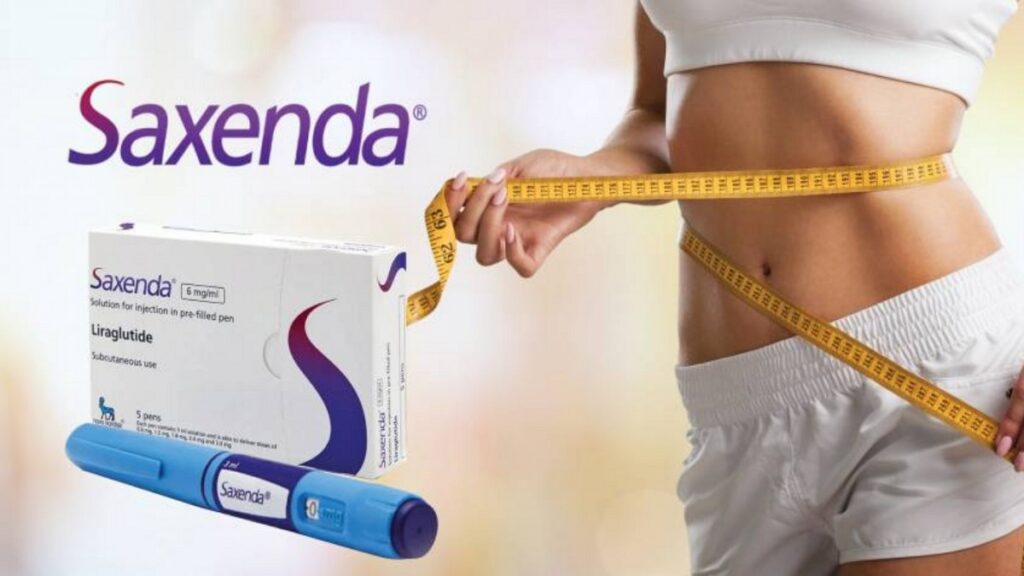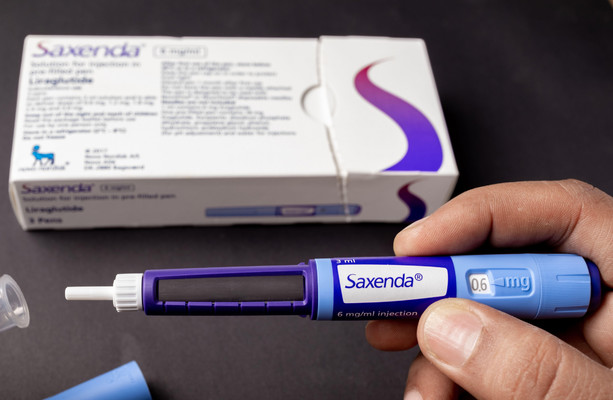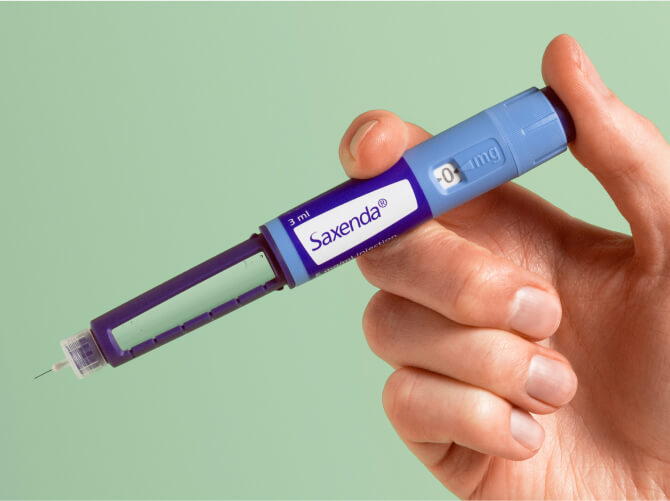Saxenda, medically known as liraglutide in Singapore, is a prescription-based injectable drug specifically developed for weight management. In the realm of obesity treatment, it has emerged as a significant pharmacological advancement. As a glucagon-like peptide-1 (GLP-1) receptor agonist, Saxenda plays a key role in controlling appetite and caloric intake.
This is particularly beneficial for individuals who have not achieved desired weight loss results with diet and exercise alone. Its inclusion in comprehensive weight management plans is supported by clinical evidence, establishing Saxenda as a reliable option in the medical management of obesity.
In terms of effectiveness, patients generally experience a reduction in body weight of about 5% after 4 months of regular use. This reduction can increase to approximately 10% after 6 to 8 months, and potentially around 12% after a year of consistent treatment.

Saxenda has shown substantial effectiveness in facilitating weight loss. Various clinical trials have indicated that its combination with a reduced-calorie diet and increased physical activity can result in significant weight reduction, especially valuable for individuals dealing with obesity or overweight conditions.
Saxenda's mechanism involves the imitation of the GLP-1 hormone, integral to appetite control. Its stimulation of GLP-1 receptors reduces hunger and enhances satiety, thereby aiding in lowering overall calorie intake and supporting adherence to weight loss diets.
Utilizing Saxenda for weight loss can also positively impact various health indicators. Notable improvements have been observed in blood pressure, cholesterol levels, and blood sugar control, which is particularly advantageous for those with type 2 diabetes.
Administered with a pre-filled injection pen, Saxenda offers convenience and adaptability for users. Its design allows for easy self-administration in various areas of the body, such as the abdomen, thigh, or upper arm, facilitating ease of use in daily routines.
Saxenda is designed not just as a temporary solution but as a part of a long-term strategy for weight management. Integrating Saxenda with a balanced diet and regular exercise can help maintain weight loss over an extended period.
In addition to physical health benefits, the use of Saxenda has been associated with positive psychological outcomes. This includes enhanced self-esteem and a decrease in symptoms related to depression and anxiety, often linked to body weight concerns.

When considering weight loss treatments in Singapore, Saxenda has emerged as a notable option, especially for individuals dealing with obesity. This section explores the efficacy and results of Saxenda, a widely recognized weight loss injection.
In a comprehensive 56-week clinical study, adults with obesity or overweight, accompanied by related health conditions, underwent treatment with Saxenda. The results showed an average weight loss of approximately 9.5kg, underlining Saxenda's role in effective weight management.
A significant number of participants reported more than 5% to 10% loss from their baseline body weight after using Saxenda. This level of weight reduction is crucial, as it holds clinical significance in enhancing overall health and well-being.
Apart from aiding in weight loss, Saxenda has been instrumental in reducing waist circumference among users. This reduction is a key indicator in lowering the risks associated with obesity-related health issues.
Reflecting on its real-world application, individuals using Saxenda as part of their weight loss regimen, which includes diet and exercise, have experienced an average weight loss of around 8kg over six months. Notably, a substantial portion of these individuals achieved weight loss exceeding 5% or 10% of their initial body weight.
Saxenda's benefits extend beyond weight loss. Users have observed improvements in various cardiometabolic risk factors, including blood glucose levels and blood pressure. These health benefits contribute to the overall effectiveness of Saxenda as a weight loss treatment.
Saxenda functions by mimicking the glucagon-like peptide-1 (GLP-1), a hormone that plays a vital role in regulating appetite. As a GLP-1 receptor agonist, its active component, liraglutide, activates these receptors akin to the natural hormone.
This activation by Saxenda enhances the feeling of fullness post-meals and diminishes hunger, leading to a decrease in overall calorie consumption. This mechanism is a cornerstone of Saxenda's effectiveness in weight loss, with users commonly reporting increased satisfaction with smaller meal portions.

A key function of Saxenda is to decelerate the gastric emptying process. By slowing down the rate at which food exits the stomach, Saxenda prolongs satiety (feeling full), thereby assisting in further reducing food intake. This slow digestion process is instrumental in enhancing the efficacy of weight loss treatments.
Saxenda significantly influences insulin secretion, prompting the pancreas to release insulin in response to elevated blood sugar levels. Enhanced insulin secretion facilitates efficient glucose absorption by cells, crucial for energy production. This attribute of Saxenda is particularly advantageous for patients with type 2 diabetes, aiding in better blood sugar management.
Additionally, Saxenda actively reduces the secretion of glucagon, a hormone that elevates blood sugar levels. By lowering glucagon levels, Saxenda contributes to maintaining stable blood sugar levels, an important factor in effective weight management and overall health, especially for individuals with diabetes.
Through these mechanisms, Saxenda stands out as a potent weight loss injection and an integral part of obesity treatment strategies. Its ability to regulate appetite, control caloric intake, and manage blood sugar levels makes it a comprehensive solution for individuals seeking effective weight management options.

Understanding who is best suited for Saxenda, a leading weight loss injection, is key to its effectiveness in obesity treatment and management. Here are the primary candidates for whom Saxenda is considered an appropriate solution:
Saxenda is specifically designed for adults who have a Body Mass Index (BMI) of 30 or above, categorizing them within the obesity spectrum. It is also suitable for those with a BMI of 27 or above who are experiencing weight-related health issues such as type 2 diabetes, high blood pressure, or elevated cholesterol levels.
For many, conventional methods like diet and exercise might not yield significant weight loss results. Saxenda serves as an effective additional treatment for these individuals, enhancing their weight management efforts when lifestyle changes alone are insufficient.
Saxenda presents a viable non-surgical option for weight management, particularly for those who are not suitable candidates for procedures like bariatric surgery. This injectable treatment offers a less invasive route to achieving weight loss goals.
It's crucial for patients to not have any medical conditions or family history that conflicts with the use of Saxenda. This includes conditions like Medullary Thyroid Carcinoma (MTC) or Multiple Endocrine Neoplasia syndrome type 2 (MEN 2).
As Saxenda is an injectable medication, it is most suitable for individuals who are comfortable with self-administering injections as part of their regular health regimen.
Understanding the distinct roles of Saxenda (liraglutide) and Rybelsus (semaglutide) in medical treatments is crucial for patients exploring their options. Both medications fall under the category of GLP-1 receptor agonists but serve different primary purposes in health management.
Saxenda is specifically engineered for weight management. Clinical research has repeatedly demonstrated its effectiveness in aiding significant weight loss among individuals with obesity or overweight, accompanied by related health issues. The defining feature of Saxenda lies in its targeted approach to weight loss, setting it apart from other medications like Rybelsus.
While Rybelsus shares the GLP-1 receptor agonist classification with Saxenda, its primary focus is the management of type 2 diabetes. It is adept at regulating blood sugar levels, offering substantial benefits to patients with diabetes. Though weight loss may occur as a secondary effect of Rybelsus, it is not as significant or consistent as the weight loss results seen with Saxenda.
Learn more about Rybelsus here
Both Saxenda and Rybelsus mimic the GLP-1 hormone to achieve their respective health outcomes. Saxenda is the go-to option for those prioritizing weight loss, particularly in cases of obesity. On the other hand, Rybelsus is the preferred choice for effective blood sugar control in patients with type 2 diabetes. The decision between these two medications should be based on the individual's primary health goal—whether it is managing weight or controlling diabetes.

Embarking on the Saxenda treatment journey involves several key stages, each crucial for ensuring the efficacy and safety of this weight loss injection. Here’s a detailed overview of the treatment process, particularly beneficial for those seeking obesity treatment solutions.
Medical Evaluation: The Saxenda journey begins with an in-depth medical assessment conducted by a healthcare provider, including BMI evaluation and medical history review.
Review of Medical Conditions: Identifying any contraindications, such as a history of thyroid cancer or pancreatitis, is vital to ensure Saxenda's suitability.
Goal Setting: Discussing realistic weight loss goals and expectations is essential in creating a comprehensive weight management plan that encompasses dietary changes, exercise, and behavioral modifications.
Dose Initiation: Treatment typically starts with a lower dose of 0.6 mg per day to minimize potential gastrointestinal side effects.
Gradual Dose Increase: The dosage is incrementally increased, usually by 0.6 mg each week, until reaching the full maintenance dose of 3 mg per day.
Training for Self-Administration: Patients learn to self-administer Saxenda using a pre-filled pen, with guidance on proper injection techniques and site rotation.
Regular Follow-Up Appointments: Continual monitoring through scheduled appointments is crucial to track progress, make necessary treatment adjustments, and manage side effects.
Tracking Progress: Regular assessments of weight, BMI, blood pressure, and glucose levels are integral to the treatment protocol.
Monitoring Adverse Reactions: Common side effects like nausea and digestive changes are closely monitored, with guidance provided on management techniques.
Dose Adjustments: The medication dose may be modified based on the patient’s response and side effect management.
Evaluating Treatment Efficacy: The effectiveness of Saxenda is periodically evaluated, typically at the 16-week mark, to determine if the treatment goals are being met.
Continuation Decision: If there is less than a 4% reduction in baseline body weight by 16 weeks, discontinuation of Saxenda may be recommended.
Sustained Weight Management: For patients who show positive responses, Saxenda can be continued as a part of a long-term strategy for maintaining weight loss.
When considering Saxenda for weight loss, it's essential to be well-informed about its potential side effects. Like most medications, Saxenda, known for its effectiveness in weight management, has side effects, which are generally manageable and tend to lessen over time. Understanding these can help ensure safe and effective use of Saxenda in your weight loss journey.
The side effects associated with Saxenda are usually mild and transient, resolving as the body adapts to the medication. These include:
Nausea: Often experienced at the beginning of the treatment, this side effect typically decreases with time.
Digestive Changes: Some individuals might encounter alterations in bowel habits, like diarrhea or constipation, which can usually be mitigated through dietary adjustments.
Appetite Reduction: Experiencing a quicker sense of fullness or changes in appetite is common and contributes to the weight loss process.
Headaches and Dizziness: These mild side effects are generally temporary and can be alleviated by staying well-hydrated.
Fatigue: A temporary increase in tiredness can occur but usually resolves as the body adjusts to Saxenda.
While serious side effects are less frequent, being vigilant and knowing when to seek medical consultation is crucial. Key areas to monitor include:
Pancreatitis Symptoms: Severe stomach pain, particularly if it radiates to the back, warrants immediate medical attention.
Gallbladder Issues: Upper stomach pain, fever, or jaundice are less common but serious symptoms that need medical evaluation.
Heart Rate Variations: Significant changes in heartbeat should be promptly addressed with a healthcare provider.
Kidney Function: Monitor any changes in urination patterns and discuss them with your doctor.
Mood Fluctuations: Any new or worsening mood changes or depression symptoms should be reported to your doctor.
Allergic Reactions: Though rare, allergic reactions like skin rashes, swelling, or breathing difficulties require immediate medical attention.
By being aware of and managing the side effects of Saxenda, users can safely incorporate this medication into their weight loss treatment plan. It's essential to maintain open communication with your doctor to promptly address any concerns for a successful and healthy weight loss journey.
Saxenda (liraglutide), a prominent weight loss injection, has specific contraindications where its use may not be advisable or is prohibited due to potential health risks. Prior to starting Saxenda, it's crucial to consult with your doctor to thoroughly assess these contraindications.
Below are the primary medical conditions that generally preclude the use of Saxenda:

Individuals with a personal or family history of Medullary Thyroid Carcinoma should avoid using Saxenda. The concern here stems from the increased risk of thyroid C-cell tumors, a known complication with GLP-1 receptor agonist treatments like Saxenda.
Patients diagnosed with MEN 2, a genetic condition that can result in endocrine tumors, are advised against the use of Saxenda due to potential complications related to this syndrome.
Saxenda is not recommended during pregnancy or while breastfeeding. If pregnancy occurs during Saxenda treatment, discontinuation of the medication is advised to avoid potential risks to the unborn child.
Individuals who have previously experienced severe hypersensitivity reactions to liraglutide or any other components in Saxenda should not use this medication. Such reactions may include severe allergic responses like anaphylaxis and angioedema.
Those with a history of pancreatitis are advised to use Saxenda cautiously. There is a noted incidence of acute pancreatitis in patients using GLP-1 receptor agonists, including liraglutide.
Patients suffering from severe gastrointestinal disorders, such as gastroparesis, should consider avoiding Saxenda. This is due to its effect of slowing gastric motility, which could exacerbate existing gastrointestinal conditions.
In the landscape of weight management and diabetes treatment, Saxenda, Ozempic, and Wegovy are frequently discussed medications. While they share similarities as GLP-1 receptor agonists, their distinct characteristics play a pivotal role in patient-specific treatment decisions.
Primary Use: Saxenda is predominantly prescribed for weight loss and is approved for individuals with obesity or excess weight, particularly those with weight-related health conditions like hypertension or type 2 diabetes.
Administration Method: Administered via daily subcutaneous injections, Saxenda fits into daily routines for consistent weight management.
Mechanism of Action: Mimicking the GLP-1 hormone, Saxenda effectively reduces appetite and calorie intake, aiding in weight loss.
Efficacy: Clinical studies validate Saxenda's significant role in weight loss, positioning it as a useful option for targeted weight management.
Primary Use: Ozempic primarily addresses type 2 diabetes management, focusing on blood sugar level control.
Administration Method: As a once-weekly injectable medication, Ozempic offers convenience in diabetes treatment schedules.
Mechanism of Action: Although similar to Saxenda in mimicking GLP-1, Ozempic prioritizes blood sugar regulation, with weight loss as a secondary benefit.
Efficacy: Ozempic has demonstrated high effectiveness in managing diabetes, improving key health markers in this area.
Learn more about Ozempic here
Primary Use: Wegovy, containing the same active ingredient as Ozempic (semaglutide), is specifically approved for adult weight loss.
Administration Method: Similar to Ozempic, Wegovy is taken once a week, offering a manageable regimen for sustained weight loss.
Mechanism of Action: It functions by reducing appetite and food intake, directly contributing to weight loss.
Efficacy: Wegovy's efficacy mirrors that of Saxenda in the weight loss realm, making it another useful candidate for obesity and weight management.
Learn more about Wegovy here
Primary Focus: Saxenda and Wegovy are primarily geared towards weight loss, while Ozempic is targeted at diabetes management.
Administration Frequency: Saxenda requires daily administration, contrasting with the weekly schedule of Ozempic and Wegovy.
Active Ingredients: Saxenda is based on liraglutide, whereas both Ozempic and Wegovy contain semaglutide, differentiated by their dosages and primary health objectives.
It's important to look for clinics that have experienced doctors and staff. They should offer a variety of treatments such as weight loss injectables like Saxenda, Ozempic, and Wegovy. Seek clinics that embrace an all-inclusive approach, offering thorough initial evaluations, bespoke treatment programs, consistent support, and straightforward cost explanations.
减肥注射在新加坡已成为帮助超重或肥胖人群有效减重的主流选择之一,特别适合那些单靠节食和运动难以实现理想体重,或是因体重相关健康问题(例如2型糖尿病)而苦恼的人士。这类注射主要通过模拟或调节体内控制食欲和新陈代谢的天然激素来发挥作用。减肥注射是处方药,需在医疗专业人士的指导下使用,不可擅自购买或使用。
这些药物通过改变身体的生理机制来帮助减重。它们通常以预装注射笔的形式存在,患者可以自行在腹部皮下注射。在众多减肥药物中,赛谷达(Saxenda)尤为出名,其有效成分利拉鲁肽(Liraglutide)已在临床上证明具有显著的减重效果。

Saxenda(利拉鲁肽)在新加坡的医疗市场中是一种处方药注射,专门用于帮助成年人进行体重管理。作为一种胰高血糖素样肽-1(GLP-1)受体激动剂,Saxenda在抑制食欲和减少热量摄入方面起到核心作用,是那些通过传统饮食和运动方法难以实现减重目标的人的福音。
Saxenda通过模拟GLP-1(胰高血糖素样肽-1)激素的作用来控制食欲。它激活GLP-1受体,减少饥饿感,增加饱腹感,从而帮助减少总体的热量摄入,支持遵守减肥饮食计划。
Saxenda作为综合体重管理计划的一部分,其有效性和安全性已获得多项临床试验验证,被视为肥胖管理的重要手段。根据研究,使用Saxenda的患者通常在治疗的前4个月内可以减轻约5%的体重。随着治疗的延续,6到8个月后,体重减轻可能增加到10%,而在连续治疗一年后,总体减重效果可以达到12%左右。
利拉鲁肽(Saxenda)在新加坡已被广泛应用于肥胖和超重人群的减重治疗中,其临床益处多样,包括有效的体重控制和对健康指标的积极影响。

Saxenda结合低热量饮食和增加体力活动的使用,已在多项临床试验中显示出显著的减重效果。对于那些面临肥胖或超重问题的人群而言,Saxenda提供了一种有效的治疗方案,帮助他们实现持久的体重管理。
Saxenda通过模拟GLP-1(胰高血糖素样肽-1)激素的作用来控制食欲。它激活GLP-1受体,减少饥饿感,增加饱腹感,从而帮助减少总体的热量摄入,支持遵守减肥饮食计划。
使用Saxenda减肥不仅有助于体重控制,还能显著改善多项健康指标。研究显示,Saxenda的使用者在血压、胆固醇水平和血糖控制方面有所改善,特别是对于2型糖尿病患者来说,这一点尤为重要。

Saxenda采用预装式注射笔进行药物给药,设计方便,用户可以轻松在腹部、大腿或上臂等多个部位自我注射,使其轻松融入日常生活。
Saxenda不仅是一种临时的减重解决方案,它旨在成为长期体重管理策略的一部分。结合均衡饮食和规律运动,Saxenda有助于长期维持体重减轻效果。
除了对身体健康的益处,使用Saxenda还与积极的心理效果有关,包括提高自尊心以及减少与体重相关的抑郁和焦虑症状。这对于改善用户的整体生活质量具有重要意义。
投身于Saxenda治疗之旅涉及几个关键阶段,每一步都至关重要,以确保这种减肥注射的效果与安全性。以下是治疗过程的详细概述,特别有益于那些寻求肥胖治疗解决方案的人士。

医学评估:Saxenda治疗之旅始于由医疗提供者进行的深入医学评估,包括BMI评估和病历复查。
审查医疗状况:识别任何禁忌症,如甲状腺癌或胰腺炎病史,是确保Saxenda适用性的关键。
目标设定:讨论现实的减重目标和期望,在此基础上制定包括饮食改变、运动和行为调整在内的全面体重管理计划。
剂量启动:治疗通常从每天0.6毫克的较低剂量开始,以最小化潜在的胃肠道副作用。
逐步增加剂量:剂量每周递增0.6毫克,直至达到每天3毫克的维持剂量。
自我管理培训:患者学习使用预装注射笔自我注射Saxenda,同时了解正确的注射技巧和部位轮换方法。
定期随访:通过预约的定期随访持续监控治疗进展,进行必要的治疗调整,并管理副作用。
跟踪进度:定期评估体重、BMI、血压和血糖水平,是治疗方案的重要组成部分。
监测不良反应:密切监控常见副作用如恶心和消化变化,并提供管理技巧指导。
剂量调整:根据患者的反应和副作用管理情况,可能会调整药物剂量。

评价治疗效果:通常在治疗开始后的16周进行Saxenda效果的定期评估,以确定是否达到治疗目标。
继续决定:如果在16周内体重减少不足4%,可能建议停止使用Saxenda。
持续的体重管理:对于显示出积极反应的患者,Saxenda可以作为长期维持体重减轻的策略部分继续使用。
在考虑使用利拉鲁肽(Saxenda)进行减肥时,了解其潜在的副作用至关重要。像大多数药物一样,虽然利拉鲁肽在体重管理方面效果显著,但它也有一些通常可以管理并会随时间减少的副作用。深入了解这些副作用有助于确保在减肥过程中安全而有效地使用利拉鲁肽。
利拉鲁肽(Saxenda)的副作用通常是轻微且暂时的,随着身体适应药物而解决。这些副作用包括:
虽然严重副作用较少见,但保持警觉并知道何时寻求医疗咨询至关重要。需监控的关键领域包括:
通过了解并管理利拉鲁肽(Saxenda)的副作用,用户可以安全地将这种药物纳入其减肥治疗计划中。与医生保持开放的沟通,及时解决任何问题,是成功和健康减肥旅程的关键。
在您考虑利拉鲁肽(Saxenda)作为减肥治疗方案时,了解全面的治疗过程、潜在的副作用及其管理方法非常关键。选择利拉鲁肽不仅是一种治疗选择,更是承诺在医疗专业人士的指导下,致力于实现健康和持续的体重管理。我们鼓励所有潜在用户与医疗提供者密切合作,制定个性化的治疗计划,确保在安全监控下优化治疗成效。通过这样的合作和承诺,利拉鲁肽可以帮助您迈向更健康、更自信的生活方式。

如果您准备开始您的减肥旅程,不要犹豫,现在就联系您的医疗服务提供者,了解更多关于Saxenda的信息,并讨论是否适合您的治疗方案。让我们一起迈出改变的第一步,体验一个更轻盈的未来。
关于Dr Edwin Lim
Dr Edwin Lim毕业于新加坡国立大学,拥有医学学士学位(MBBS)和超过12年的临床经验。他是爱丁堡皇家外科医学院(MRCS)的会员,并在卡迪夫大学获得实用皮肤病学硕士学位。此外,他还持有卡迪夫大学的实用皮肤病学研究生文凭和美国美容医学学会的美容医学文凭。
关于诊所
我们是顶级医疗美容诊所,在新加坡设有两个方便的分店:
东部诊所:位于#02-12/13 Changi City Point Shopping Mall。这里停车方便,商场内购物设施齐全,并有直达地铁站的地下通道连接Expo MRT。
乌节路诊所:位于#05-51 Lucky Plaza, Orchard Medical Specialists Centre。诊所提供隐私和专属服务,设有直达医疗楼层的电梯,并通过有盖的地下通道连接乌节地铁站,途经义安城和Wisma Atria。
我们的诊所提供全面的医疗美容服务,配备先进技术,帮助您以最小的疼痛和恢复时间实现最佳状态。我们致力于为每位患者提供个性化、专业化的美容治疗,以满足您独特的需求。
立即行动
如果您准备开始您的减肥旅程,不要犹豫,现在就联系您的医疗服务提供者,了解更多关于Saxenda的信息,并讨论是否适合您的治疗方案。让我们一起迈出改变的第一步,体验一个更轻盈的未来。
您可以通过以下联系方式找到我们:
东部诊所:#02-12/13 Changi City Point Shopping Mall
乌节路诊所:#05-51 Lucky Plaza, Orchard Medical Specialists Centre
我们的座机号码是69042218。
您也可以通过Whatsapp联系我们,号码是+6596372218。
我们的电子邮件是hello@edwinlimclinic.sg。
我们期待为您提供优质的医疗美容服务,帮助您实现美丽与自信。